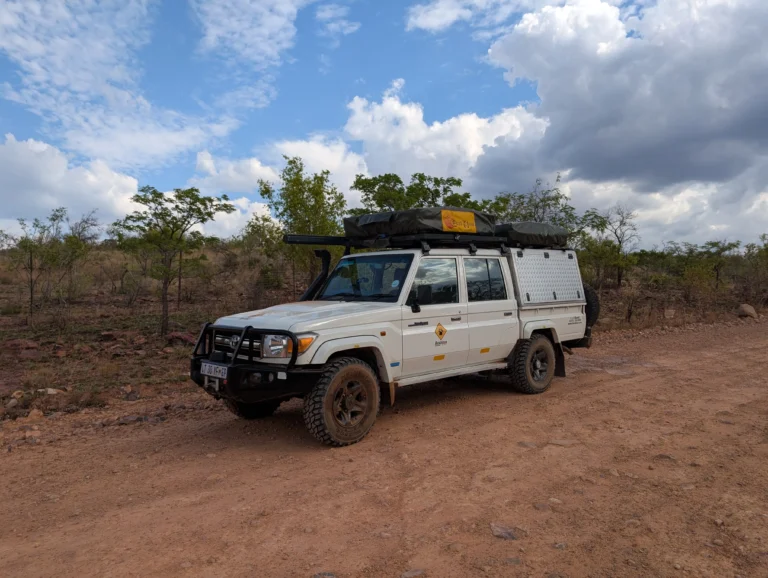On This Page
Introduction — Why this 18-day overland safari works
This 18-Day Safari: Johannesburg to Cape Town via Namibia follows a practical sequence: short shakedown days first, then longer Kalahari stretches, then Namibia’s deserts and canyons, and finally the Western Cape coast. It balances wildlife, scenery, and border logistics. On Day 4, a lion roared near our camp in the Central Kalahari Game Reserve in the middle of the night around 2 am. We were not prepared for it, so it was quite frightening.
Primary intent here is informational and planning: you’ll find a day‑by‑day itinerary, border notes, terrain expectations, safety tips, and a simple cost summary. Where relevant, I link to official park pages and resources.
Planning essentials (quick)
- Vehicle: High‑clearance 4×4 is non-negotiable for Khutse, Central Kalahari, and Kgalagadi. Carry at least 10–20L emergency water and a second spare where possible. Have a look at further tips from SANParks for the Kgalagadi.
- Fuel & permits: Pay park conservation fees at gates or even better prepay the fees whereever possible, keep cash & cards. Cross‑border paperwork for the vehicle (police clearance or rental letter) is essential.
- Navigation: Offline maps (e.g. Tracks4Africa) + a paper map for contingencies. Cell coverage is non-existent in large parts Botswana, plan your commumication windows.
- Money: I list costs in USD for travelers, local currencies (ZAR/BWP/NAD) are noted where useful.
Choosing Your Vehicle: The Most Critical System
Your vehicle is the central component of this entire trip. It’s your transport, kitchen, bedroom, and lifeline. For a group of three on a route this demanding, a standard double-cab with a rooftop tent is too cramped. We made a strategic decision to rent a specialized vehicle: the Toyota Land Cruiser 79 4×4 Bush Camper from Bushlore.
This isn’t a typical rental; it’s an integrated overlanding system. Here’s how it compares to other options and why it was the optimal choice for us.
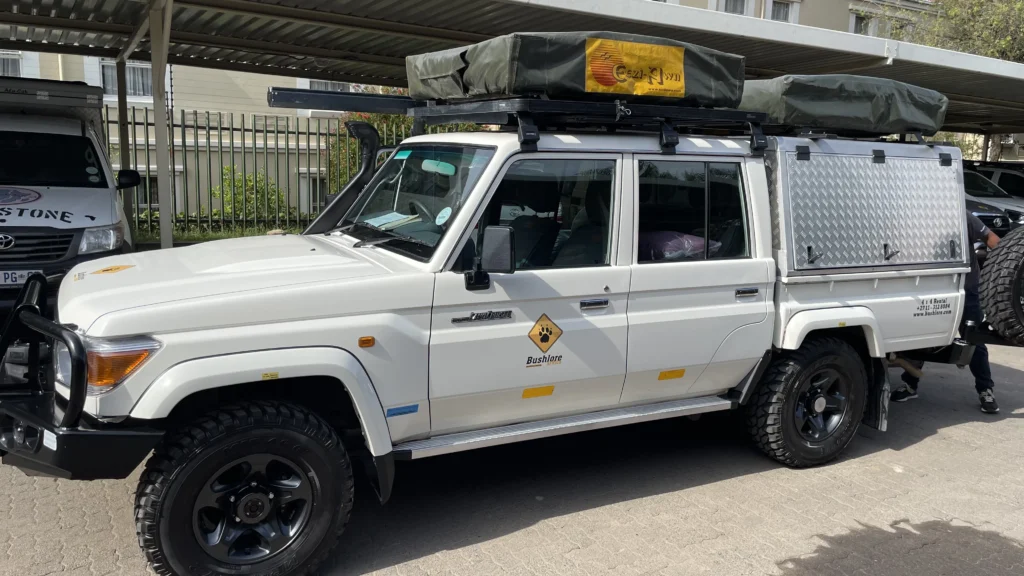
| Vehicle Type | Our Choice: Land Cruiser Bush Camper (Bushlore CruC4) | Alternative: Double Cab w/ Rooftop Tents |
|---|---|---|
| Sleeping Capacity | Sleeps up to 4 (2 in rooftop tent, 2 inside). Perfect for 3 people with room to spare. | Sleeps 2-4, but requires two separate rooftop tents, which is cumbersome and less secure for a group. |
| Living Space | Integrated internal living space. You can access the fridge and gear from inside the canopy, a huge advantage in bad weather or when lions are nearby. | Strict separation between cab and canopy. All living is done outside, which can be a challenge in rain, wind, or dust. |
| Setup Time | Faster setup. The main living space is always ready, and only the rooftop tent needs to be deployed. | Slower. Setting up and breaking down two separate rooftop tents and organizing gear from an external canopy takes significantly more time each day. |
| Capability | Built on the legendary Land Cruiser 79 chassis, it has extreme off-road capability, a powerful engine, and excellent ground clearance. | Equally capable, but the living logistics are less efficient for a group. |
The integrated camper was the single best decision we made for a group of three. The dual-battery system ran our fridge 24/7 for 18 days without a single issue, which is a critical system requirement for a trip of this length.
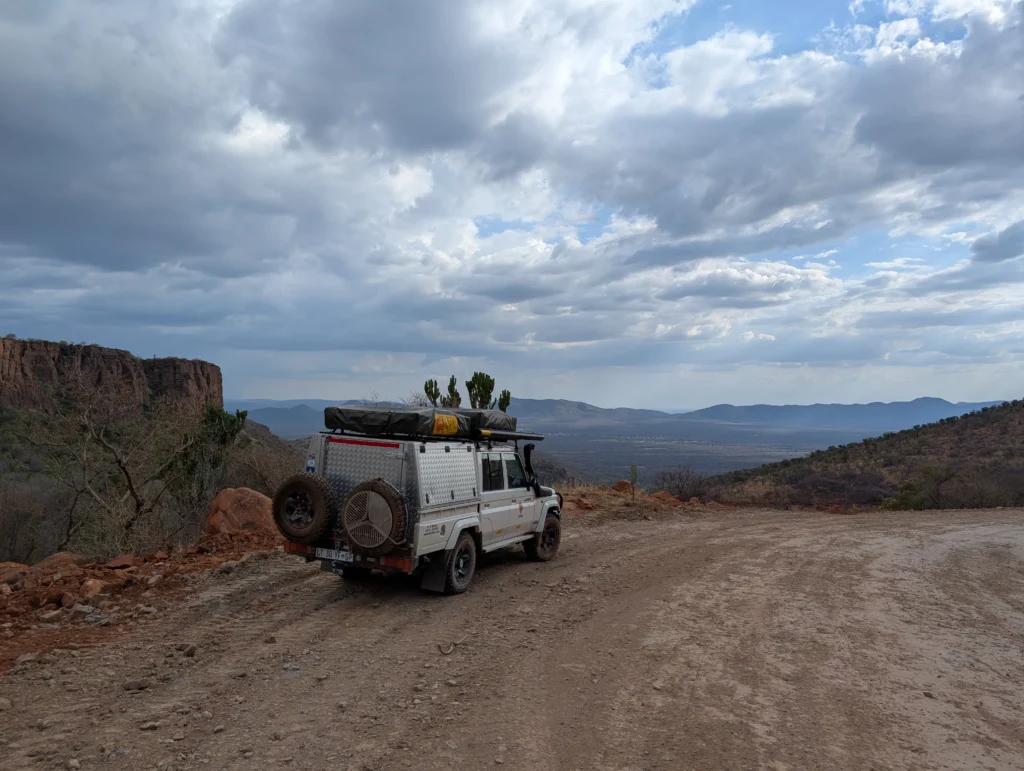
Route overview (Johannesburg → Cape Town)
| Day | Stop (Country) | Theme | Why it matters |
|---|---|---|---|
| 1 | Johannesburg (South Africa) | Setup | Supplies, SIM, vehicle checks |
| 2 | Bontle Campsite (Marakele NP, South Africa) | Wild start | Unfenced camp with frequent wildlife visits |
| 3 | Legora Bush Camp (Marakele NP, South Africa) | 4×4 Test | Remote, unfenced wilderness camp in the mountains |
| 4 | Khutse Campsite (Botswana) | Wilderness | Remote Kalahari pans; deep sand driving |
| 5 | Kang Ultra Stop Lodge (Botswana) | Reset | Fuel, supplies on the Trans‑Kalahari corridor |
| 6 | Khiding Camp 2 (Mabuasehube, Botswana) | Deep Desert | Wild pan camping; iconic Kalahari lion encounters |
| 7 | Nossob Rest Camp (Kgalagadi, South Africa) | Predator Corridor | Famed for lion/cheetah sightings in the riverbed |
| 8 | Twee Rivieren Rest Camp (Kgalagadi) | Gateway Hub | Admin HQ, fuel, shops, pool, last reliable signal |
| 9 | Torgos Lodge (Namibia) | Border Shift | Near Mata‑Mata; a soft‑landing in Namibia |
| 10 | Bagatelle Kalahari Game Ranch (Namibia) | Dunescape | Red sand dunes, cheetah conservancy experiences |
| 11 | Hakos Astrofarm (Namibia) | Dark Sky Sanctuary | High-altitude stargazing and astronomy focus |
| 12 | Sossus Oasis Campsite (Namibia) | Iconic Dunes | Base camp for Sossusvlei, Deadvlei, and Dune 45 |
| 13 | Klein-Aus Vista Desert Horse Campsite | Desert Horses | Base for feral horses, Lüderitz, and Kolmanskop |
| 14 | Ai-Ais Campsite (Fish River Canyon, Namibia) | Geological Scale | Hot springs and the southern terminus of the canyon |
| 15 | Glybank Campsite (South Africa) | Mountain Desert | Remote campsite in the rugged Richtersveld NP |
| 16 | Skilpad Restcamp (Namaqua NP, South Africa) | Floral Kingdom | Heart of the wildflower region; succulent Karoo |
| 17 | Beaverlac Camp (South Africa) | Decompression | Cederberg foothills, rock pools, and greenery |
| 18 | Cape Town (South Africa) | Finish Line | Winelands, Table Mountain, coastal drives |
Day-by-day itinerary with enhanced on-the-ground details
Day 1 — Johannesburg, South Africa
This is your system setup day. Pick up the vehicle and perform a detailed systems check: inspect tyres (including the second spare), compressors, jack points, and recovery points. Do a full photo log of the vehicle’s condition. Procure all supplies: long-life food, 20–30L of drinking water, and a basic medical kit. If renting, triple-check that you have the correct cross-border paperwork at the counter.
Day 2 — Bontle Campsite (Marakele National Park), South Africa
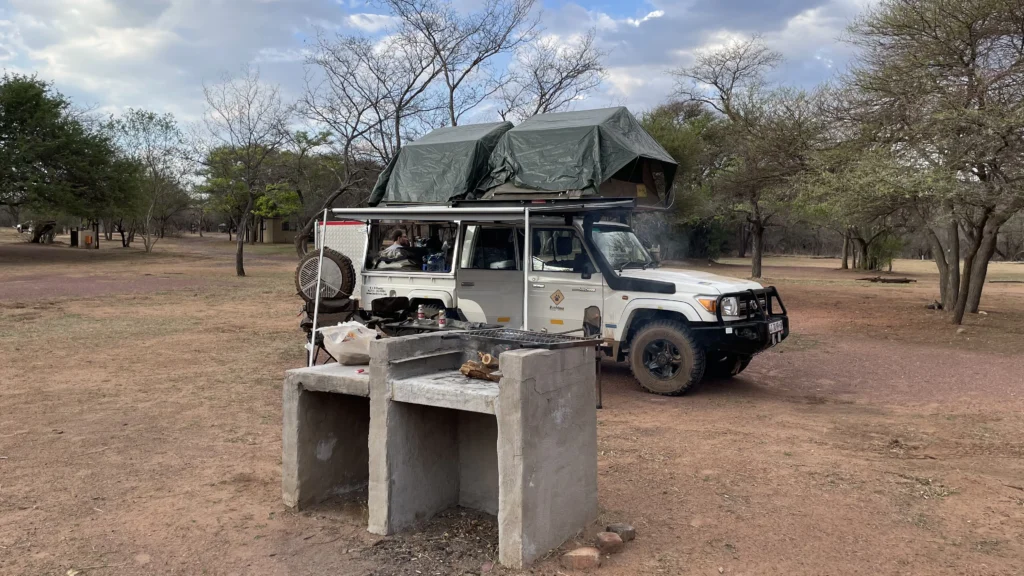
A perfect shakedown stop. Bontle camp is unfenced on the lower plains, so rhino, kudu, and warthogs often wander through the campsites. It’s an accessible introduction to SANParks facilities and a chance to test your camping setup in a controlled but wild environment before heading into the deep bush.
Day 3 — Legora Bush Camp (Marakele National Park), South Africa
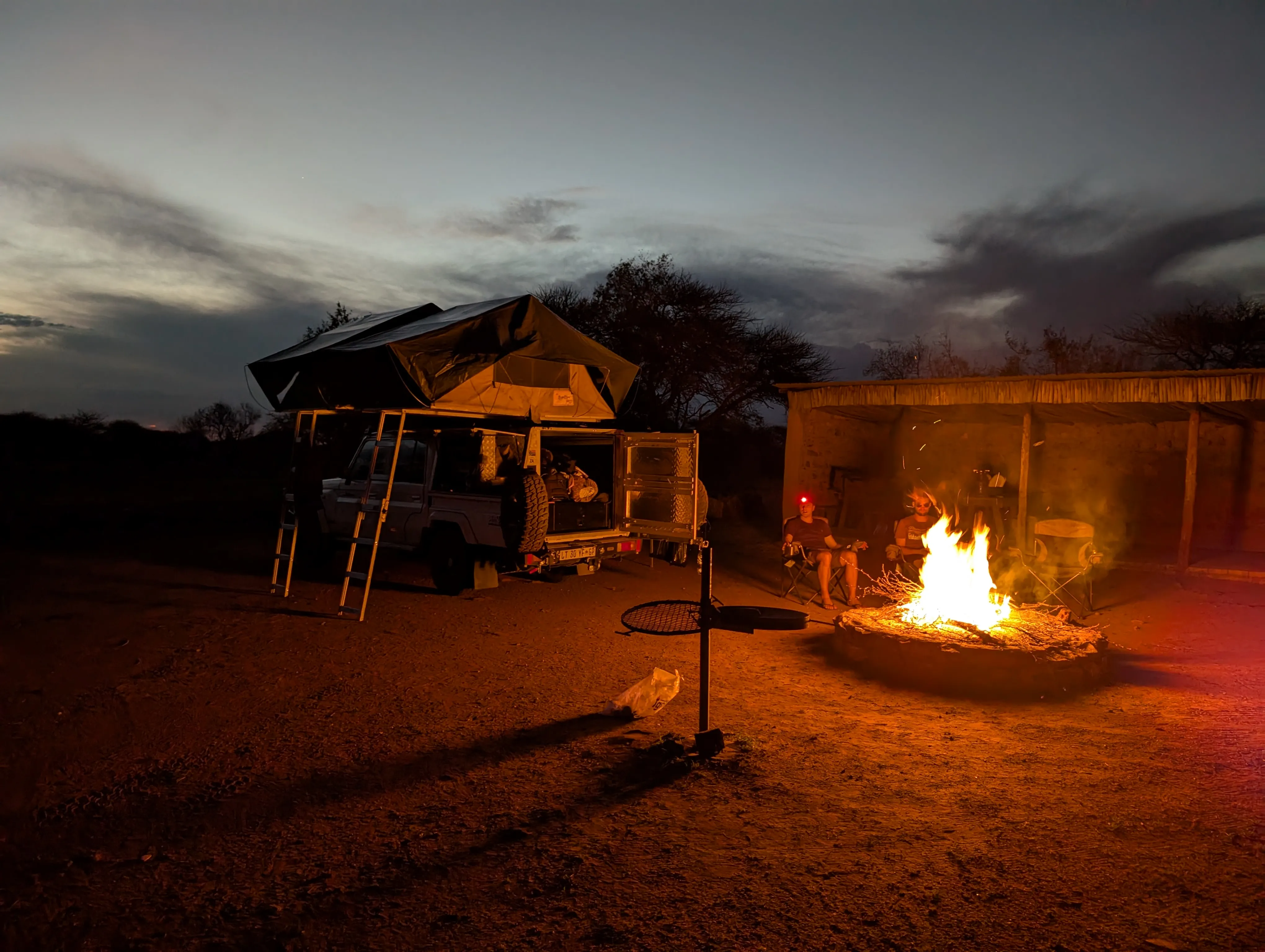
This is the first real test of your vehicle and your nerve. Legora is a remote, unfenced bush camp deep in the mountainous section of Marakele, accessible only via a steep 4×4 track. There are no facilities—no water, no power, no ablutions. It’s just you and the wilderness. This stop serves as a crucial shakedown for the rugged, self-sufficient camping to come in Botswana.
Day 4 — Khutse Campsite, Botswana
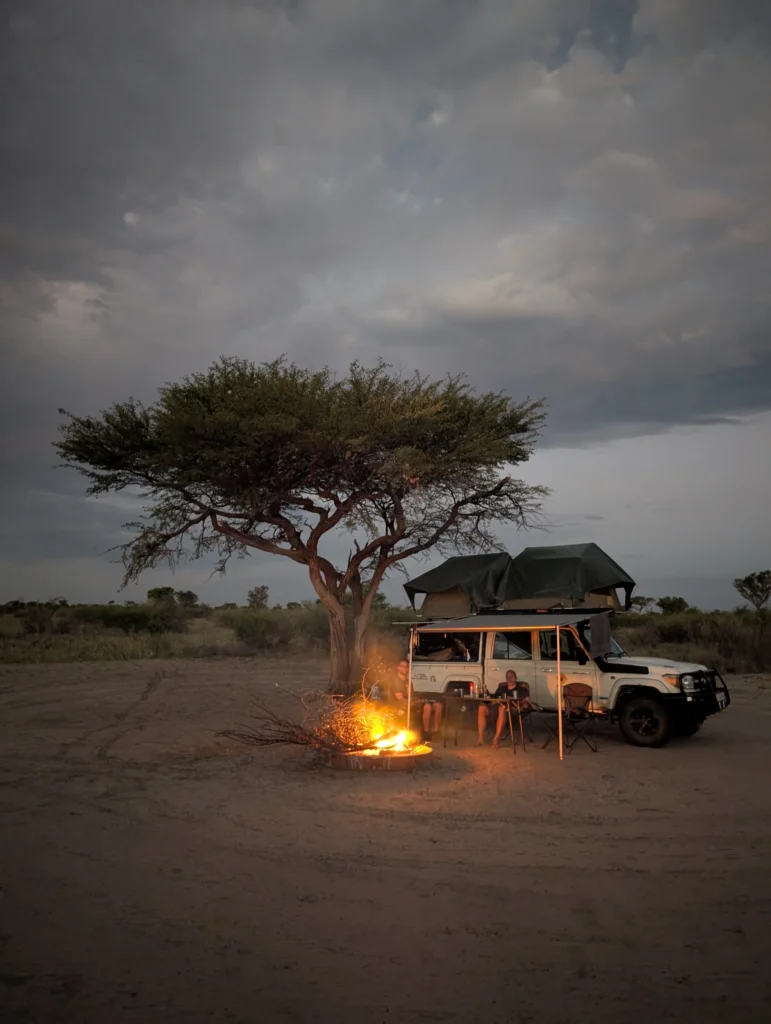
Crossing into Botswana, the roads quickly turn to deep sand, requiring a 4×4 and reduced tyre pressure (around 1.6-1.8 bar). Khutse is the southern gateway to the massive Central Kalahari Game Reserve (CKGR). Campsites are extremely rustic, often with just a pit latrine and a fire pit. You must be fully self-sufficient with water, food, and fuel.
Day 5 — Kang Ultra Stop Lodge, Botswana
Not a destination, but a critical logistical node. After the isolation of Khutse, Kang is your system reboot. It’s located directly on the paved A2/Trans-Kalahari corridor. Refuel your vehicle and your supplies, check your messages on the first available Wi-Fi in days, and enjoy a meal you don’t have to cook yourself. This stop is essential for breaking up the long Kalahari crossings.
Day 6 — Khiding Camp 2 (Mabuasehube), Botswana
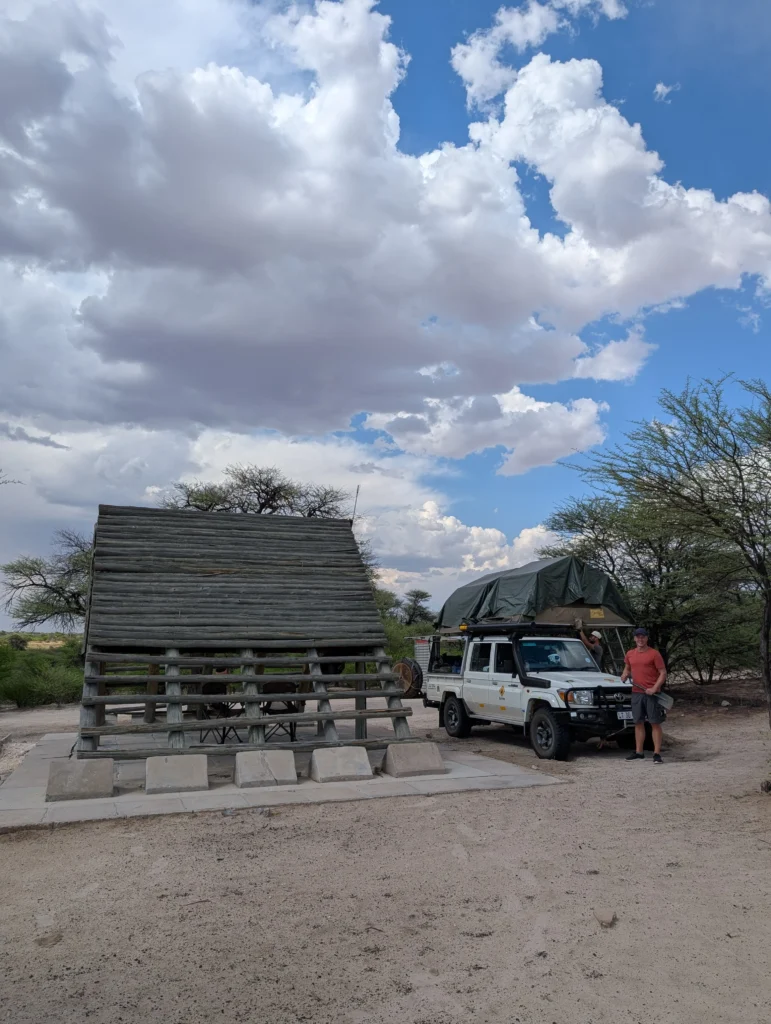
Welcome to one of the wildest public camping experiences in Southern Africa. The Mabuasehube section of the Kgalagadi is famous for its unfenced campsites overlooking vast pans. This is prime predator territory, and lions are notoriously common visitors. Khiding Camp 2 offers excellent solitude and a true wilderness feel. Facilities are minimal: an A-frame for shade and a pit latrine. You are completely on your own.
Day 7 — Nossob Rest Camp (Kgalagadi Transfrontier Park), South Africa
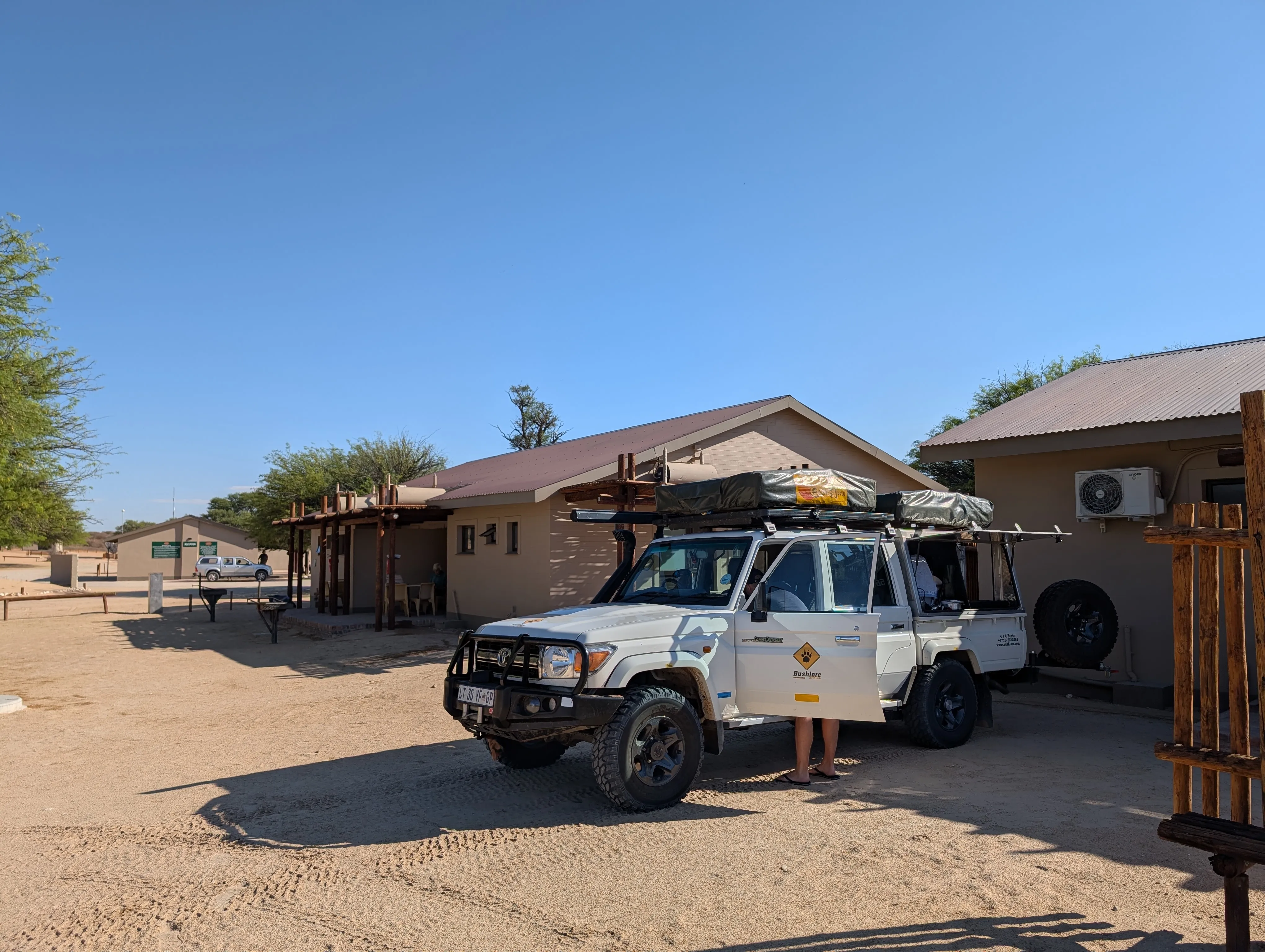
After the raw wilderness of Mabuasehube, Nossob feels like a metropolis, yet it’s one of the most remote camps in the South African park system. It’s strategically located in the dry Nossob riverbed, a natural highway for predators. The camp has a shop, fuel, a swimming pool, and a fantastic floodlit waterhole. Electricity runs on a generator for about 16.5 hours a day, and there is absolutely no cell reception.
Day 8 — Twee Rivieren Rest Camp (Kgalagadi), South-Africa/Botswana border hub

This is the administrative and logistical heart of the Kgalagadi. It has the best-stocked shop, a restaurant, a pool, and is the only camp with reliable cell phone reception. Use it to download weather forecasts, update family, and perform any necessary admin. It’s the logical place to do laundry and prepare for the Namibian leg of the journey.
Day 9 — Torgos Lodge (near Mata-Mata), Namibia

A “soft-landing” into Namibia. After days of dusty, self-catered camping, a night at a lodge just across the border is a strategic comfort reset. You cross out of the park at the Mata-Mata border post (check its operating hours), complete Namibian immigration, and drive a short distance. This allows you to start the next day fresh.
Day 10 — Bagatelle Kalahari Game Ranch, Namibia
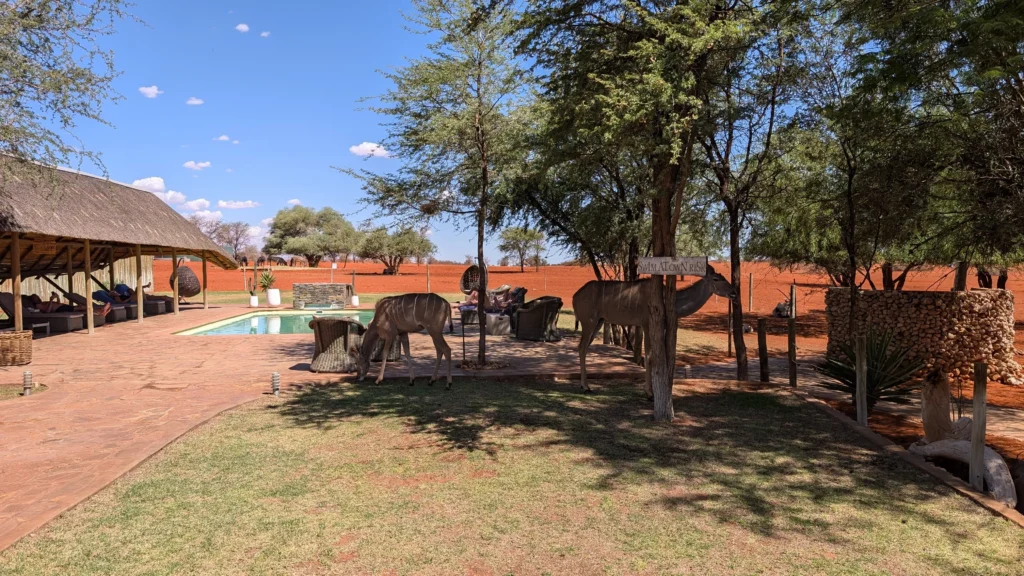
Experience a different side of the Kalahari. Unlike the flat, wild pans of Botswana, here the landscape is dominated by stunning parallel red sand dunes. Bagatelle offers guided activities, including cheetah conservation experiences, that provide a more structured and educational counterpoint to the wild encounters of the Kgalagadi.
Day 11 — Hakos Astrofarm, Namibia
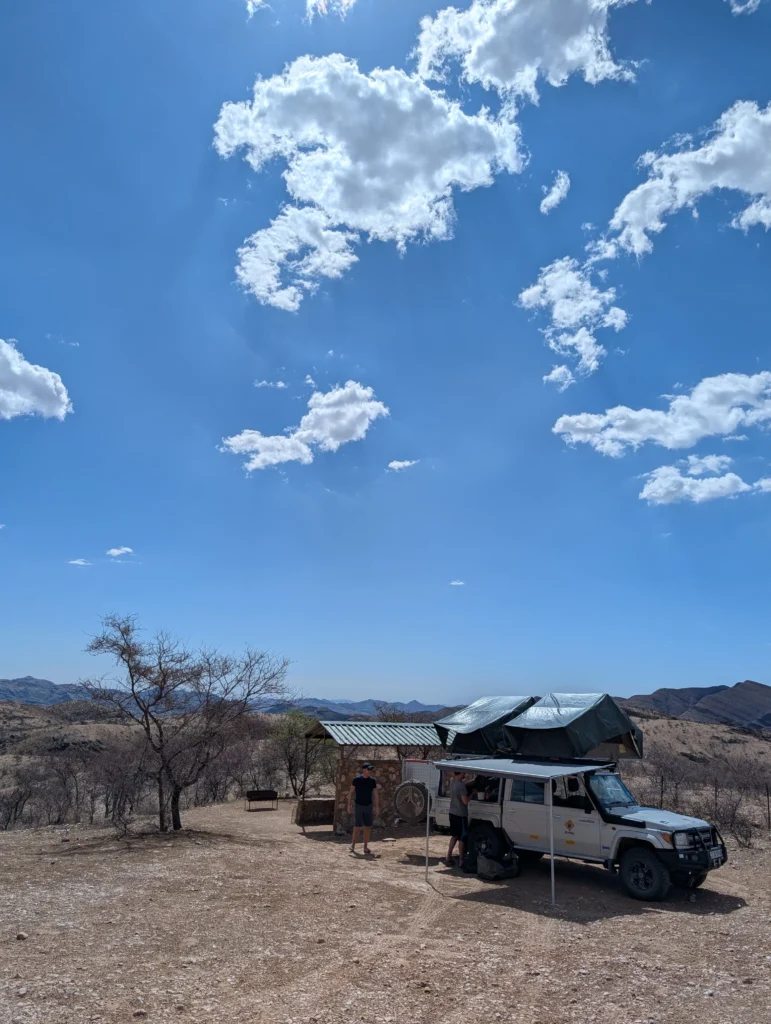
This stop is about appreciating the night sky. Located high in the Gamsberg mountains, Hakos is a working guest farm renowned among amateur and professional astronomers for its clear, dark skies. It’s less about luxury and more about an authentic, science-focused experience, offering observatory tours and a chance to look through powerful telescopes.
Day 12 — Sossus Oasis Campsite, Namibia
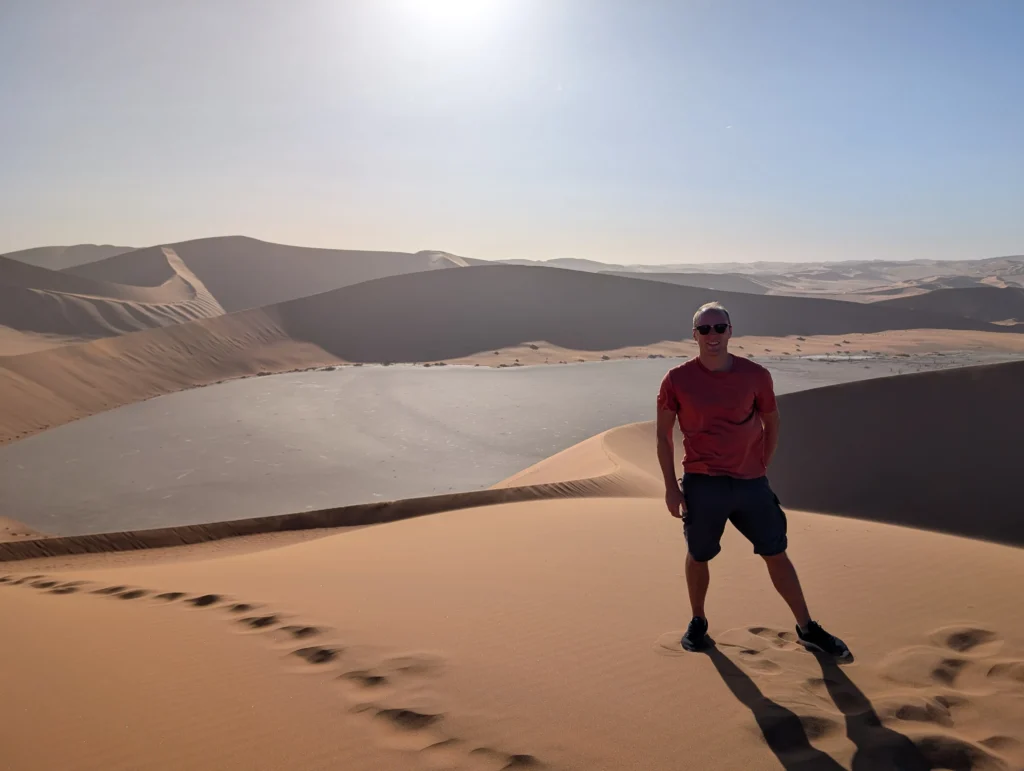
This is your logistical base for exploring Namibia’s most iconic landscape. Located in Sesriem, right outside the national park gate, this campsite provides easy access to the towering red dunes of Sossusvlei, the surreal clay pan of Deadvlei, and the oft-photographed Dune 45. It has excellent facilities, including a pool and a well-stocked shop.
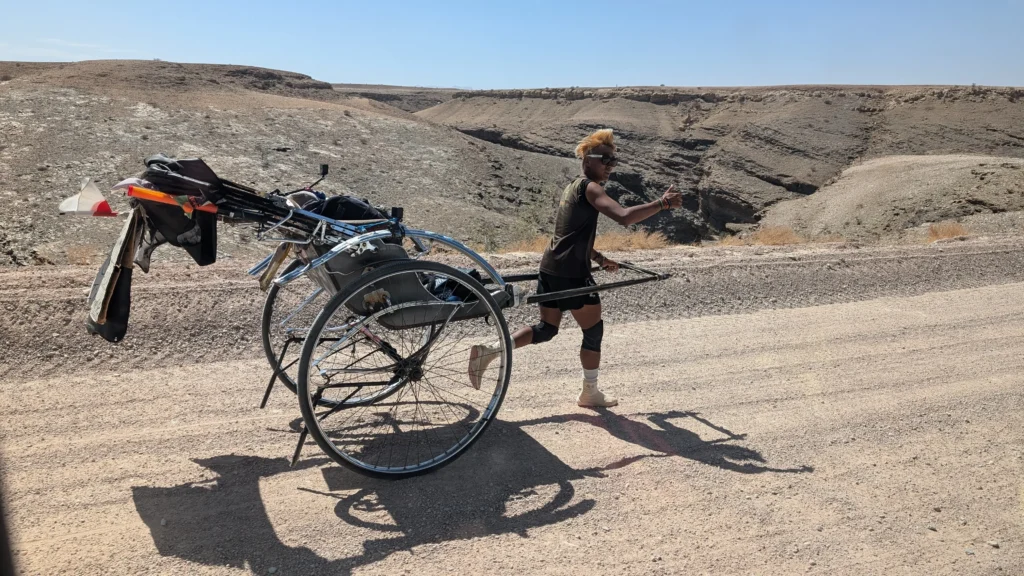
Day 13 — Klein-Aus Vista Desert Horse Campsite, Namibia
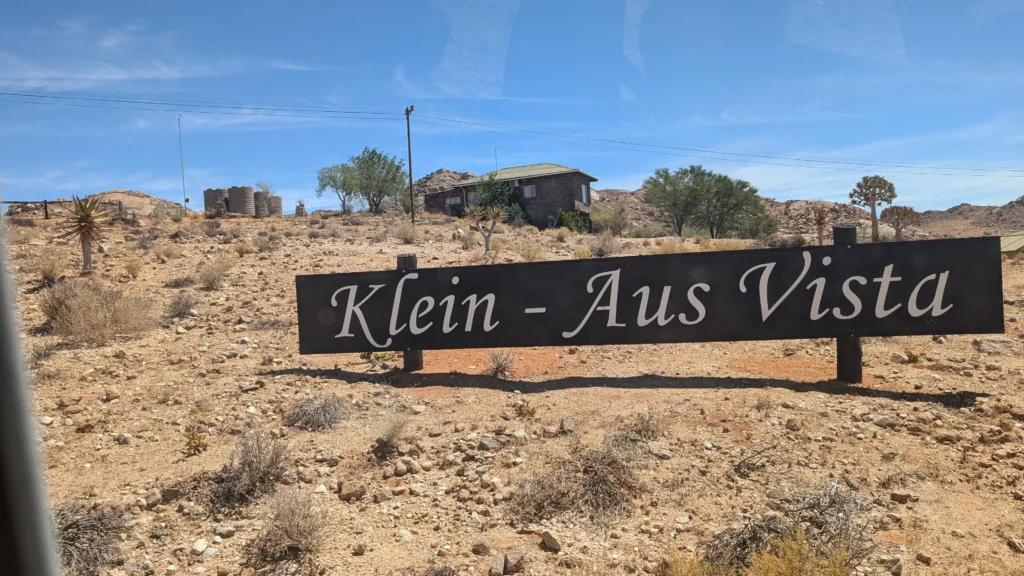
A beautifully situated campsite nestled in granite hills. Its primary purpose is to serve as a base for two key attractions: searching for the enigmatic feral desert horses of Aus and taking a day trip to the coastal town of Lüderitz and the ghost town of Kolmanskop. The site has private ablutions and fantastic views.
Day 14 — Ai-Ais Campsite (Fish River Canyon), Namibia
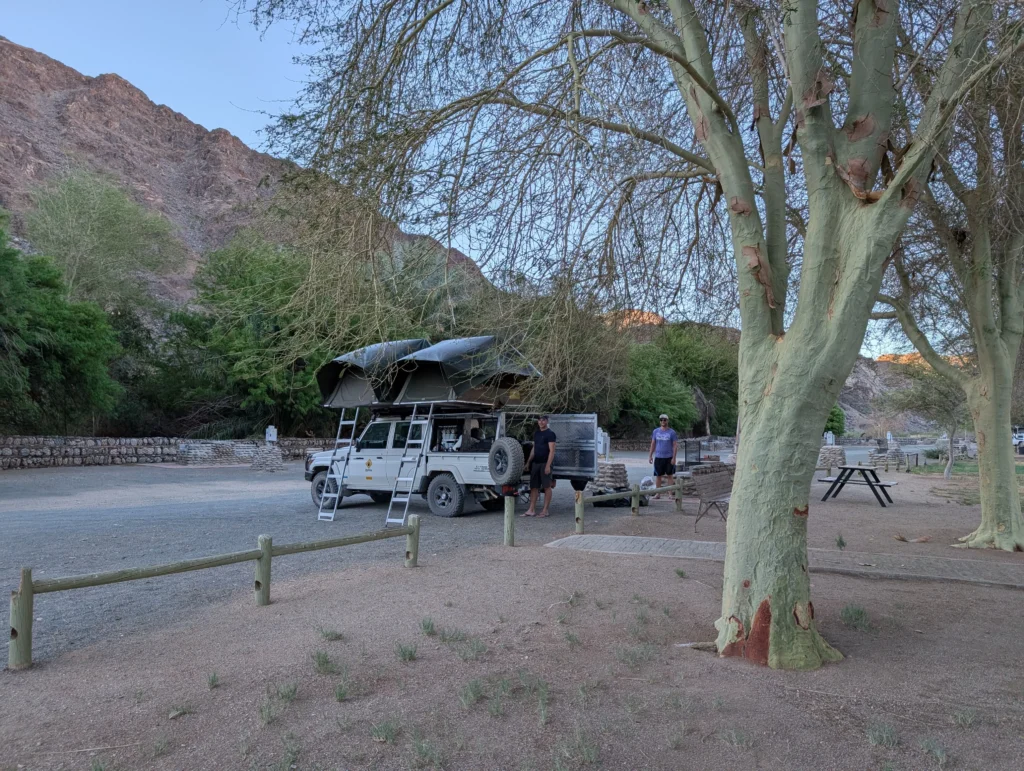
Located at the southern end of the Fish River Canyon, the main attraction here is the hot springs. The name /Ai-/Ais means “burning water” in the local Nama language. After weeks of dusty travel, soaking in the thermal baths is a perfect way to recover. The campsite is part of a larger resort complex with a restaurant and spa.
Day 15 — Glybank Campsite, South Africa
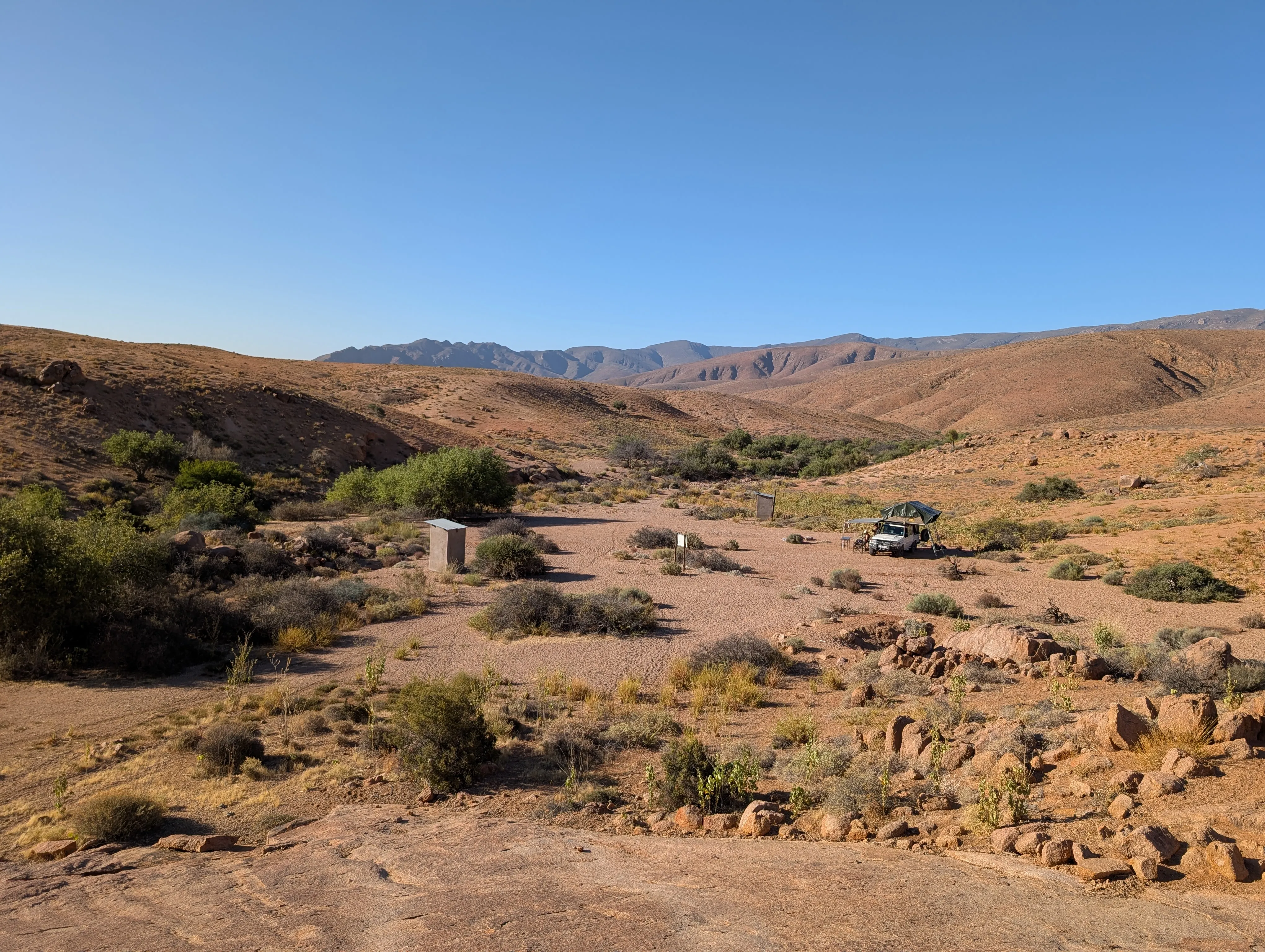
The final 4×4 challenge. Re-entering South Africa, you tackle the raw, mountainous desert of the Richtersveld National Park. Glybank is a very basic, remote campsite on the banks of the Orange River. It’s unfenced and offers incredible solitude. The tracks to reach it are rocky and require careful driving, rewarding you with a true wilderness experience. I would not recommend it, next time I would choose something different.
Day 16 — Skilpad Restcamp (Namaqua National Park), South Africa
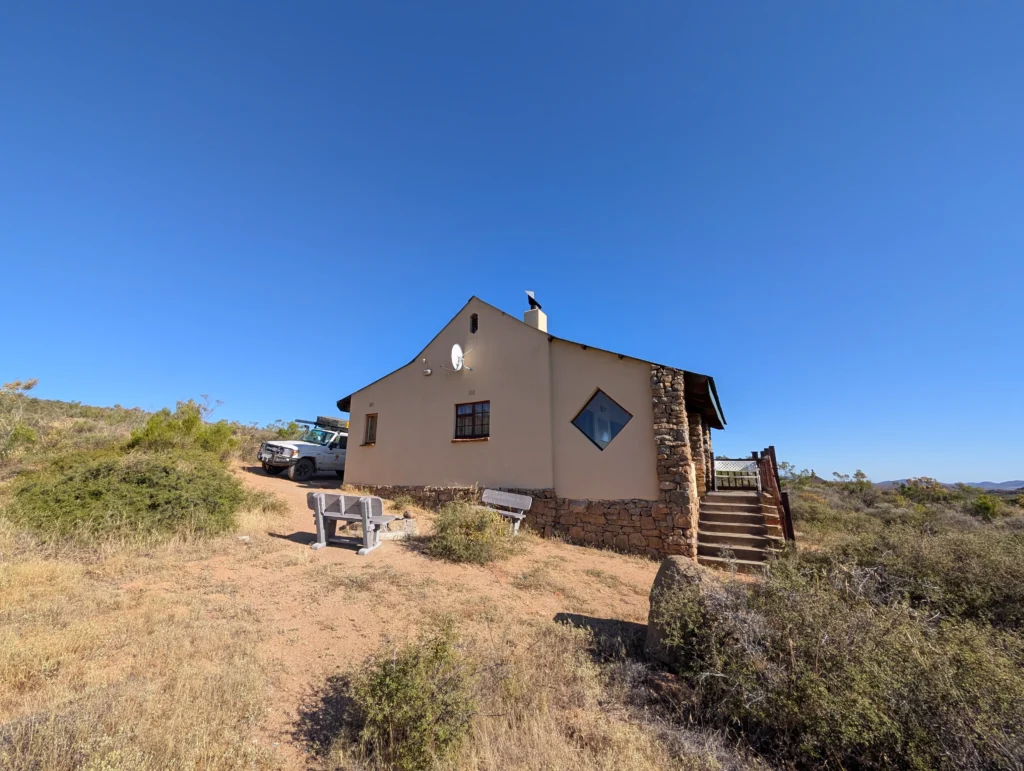
This stop is all about timing and botany. Skilpad is the main administrative camp in Namaqua National Park. For about two months a year (typically August-September), the surrounding area explodes into a world-famous carpet of wildflowers. For the other ten months, it’s a quiet, starkly beautiful landscape showcasing the Succulent Karoo biome.
Day 17 — Beaverlac Camp, South Africa
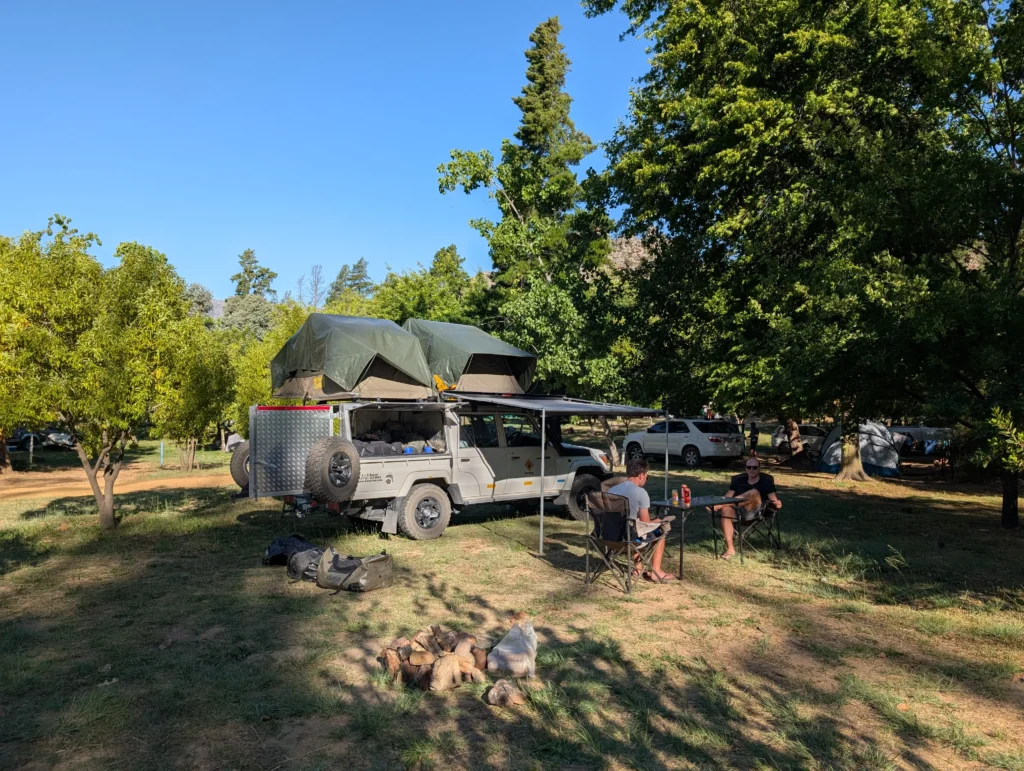
The final decompression stop. After weeks of arid landscapes, Beaverlac, high in the Cederberg foothills, is a sensory reset. The key attractions are the fresh-water rock pools and small waterfalls, perfect for a swim. It’s a rustic, back-to-basics campsite that serves as the perfect buffer before re-entering the urban environment of Cape Town.
Day 18 — Cape Town, South Africa
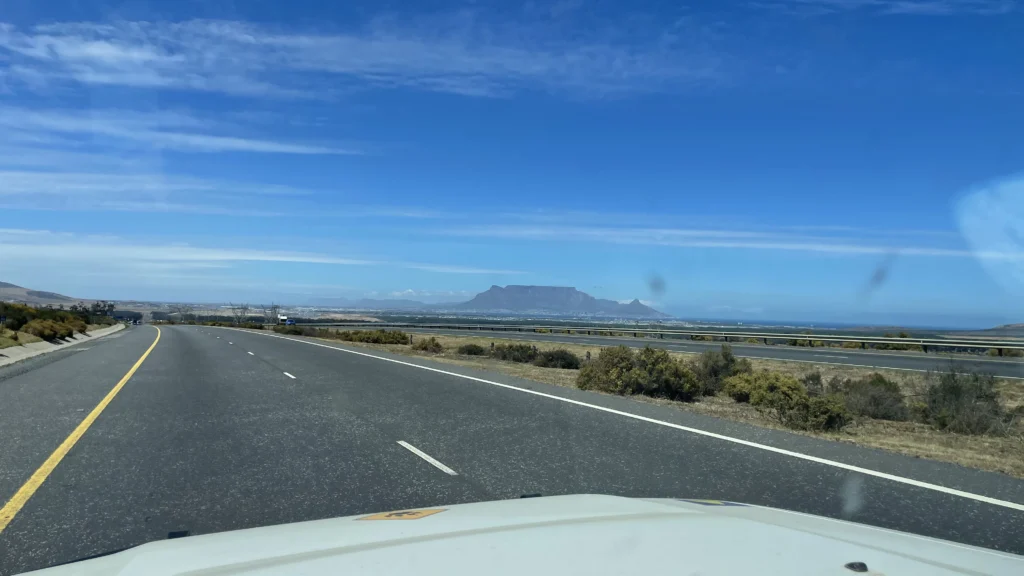
The finish line. The drive from Beaverlac to Cape Town is the last leg. You can take the direct N7 highway, or, for a final scenic reward, route through the historic Bainskloof Pass to the town of Wellington. This stunning pass offers incredible views and is a fitting end to an epic overland adventure.
What makes this route special
- Ecological diversity: From thornveld and pans to dune seas, granite kopjes, river canyons, and fynbos. Richtersveld’s fog‑fed succulents and Namaqua’s floral displays are world‑class.
- Dark skies: Hakos Farm provides an unforgettable stargazing experience with minimal light pollution.
- Logistics done right: The sequence reduces backtracking and aligns resupply.
- It sounds like a lot traveling ~5000km in this short amount of time but it is manageable. Obviously you can also adapt the route to a more relaxed trip.
Common mistakes to avoid
- Underestimating sand and range—deep Kalahari stretches burn fuel; plan extra.
- Arriving late at border posts—Mata‑Mata has fixed hours; allow buffer.
- Assuming cell coverage—Large parts of the route have none. Plan your communication windows.
- Ignoring seasonal nuances—Namaqua flowers peak Aug–Sep; Fish River hikes are seasonal.
Methodology — A systems approach to a 5,000 km loop
I built this plan like a technical project: constraints (borders, road types, fuel range), milestones (resupply hubs), and risk buffers (remote days followed by recovery nights). I used official park sources for facilities and access, rural road intel for corridors, and capped daily driving to avoid fatigue.
Cost summary
Cost Summary (USD, 3 people for 18 days)
| Category | Estimate (USD) | Notes |
|---|---|---|
| Vehicle Rental (4×4 Camper) | ~$3,500 | A fully-equipped Land Cruiser Bush Camper from Bushlore, including all camping gear. |
| Fuel & Tolls | ~$1,200 | Based on ~5,000 km with significant sand driving, which increases consumption. |
| Accommodation | ~$1,000 | A mix of DWNP/SANParks campsites, private campsites, and a few comfortable lodge nights. |
| Food & Supplies | ~$1,500 | Includes all groceries for self-catering, drinks, firewood, and dinners at lodges/restaurants. |
| Park Fees & Permits | ~$200 | Conservation fees for parks in Botswana and Namibia (not covered by Wild Card). |
| SANParks Wild Card | ~$200 | Covers entry for 2 people to all SANParks (Marakele, Kgalagadi, Richtersveld, Namaqua). A 3rd person pays separately. |
| Activities & Miscellaneous | ~$1,000 | Includes guided drives (e.g., Bagatelle), Kolmanskop permits, tips, SIM cards, and other incidentals. |
| Total (est.) | ~$8,600 | Approximately $2,860 per person for the entire 18-day trip which is pretty amazing for such an experience. |
Frequently Asked Questions
Do I need a 4×4 for the entire 18‑day safari?
High‑clearance 4×4 is non-negotiable for Khutse, Mabuasehube, and Richtersveld. Main corridors are paved, but desert sections are sandy, rocky, and remote.
What’s the best season for this route?
Winter (May-Sep) is cooler for Kalahari driving and canyon hikes; Namaqua flowers peak Aug–Sep. Summer (Oct-Apr) brings dramatic thunderstorms and baby animals but also intense heat and higher risk of getting stuck in wet sand.
Can I book last minute?
Highly unlikely. Key camps (Mabuasehube, Kgalagadi, NamibRand) book out many months, sometimes over a year, in advance. Book your campsites first and build the rest of your itinerary around those fixed dates.


